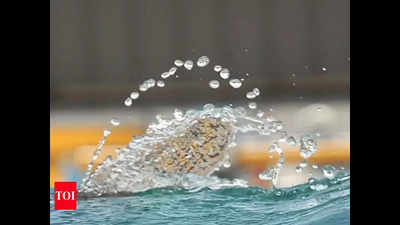- News
- City News
- delhi News
- Government tells SC it has a plan to revive 201 waterbodies
Trending
This story is from November 28, 2018
Government tells SC it has a plan to revive 201 waterbodies

Representative image
NEW DELHI: With the national capital staring at an alarming situation of reaching zero groundwater level by 2020, the Delhi government on Tuesday told the Supreme Court that it has prepared a time-bound action plan to revive 201 of the 1,011 identified waterbodies in the state to avert the looming crisis.
Appearing before a bench of Madan B Lokur, S Abdul Nazeer and Deepak Gupta, Delhi government counsel D N Goburdhun informed the court that Delhi Jal Board and department of irrigation & flood control have prepared an action plan for rejuvenation of 201 waterbodies and would soon come out with their implementation plan.
Goburdun said a pilot project had been initiated by the department at Gogha dairy in northwest Delhi where contaminated water from the local village would be treated with phytorid technology and used for groundwater recharging. He informed the court that the government is taking help of specialised agencies, including IIT Delhi and National Environmental Engineering Research Institute (NEERI), for reviving the waterbodies in the state.
“A project has been initiated by Delhi Jal Board by giving consultancy contract to a government corporation, Water and Power Consultancy Services, as a consultant which will submit a detailed project report for rejuvenation of 12 waterbodies. Another consultancy assignment for 93 waterbodies has been given to IIT, Delhi. The remaining waterbodies out of the 201 selected have also been taken up through NEERI. After submission of report, physical work for rejuvenation of waterbodies shall commence,” he said.
Compiling data on groundwater level from 2000 onwards, the CGWB in its report said water level at all of its 20 monitoring stations witnessed steady decline and areas around Chhatarpur, Dwarka and President’s Estate were the worst hit. As per the report, 27.2% of 1,483 sq km of NCT area had groundwater to the level of 0-5 metre in 2010 but in 17 years, the area has shrunk to 11.6% of the area. In 2000, the level of groundwater had not gone beyond 40 metres but at present 15% of Delhi, which is around 222 sq km, has water level of 40-80 metres.
The bench, however, questioned the government on why it had selected only 201 waterbodies and not the rest of the waterbodies. Goburdun said it was not possible to rejuvenate all waterbodies at one go as it would be a huge task and difficult to manage.
The court directed the government to fe a comprehensive report and also take steps to curb dumping of waste in waterbodies.
Appearing before a bench of Madan B Lokur, S Abdul Nazeer and Deepak Gupta, Delhi government counsel D N Goburdhun informed the court that Delhi Jal Board and department of irrigation & flood control have prepared an action plan for rejuvenation of 201 waterbodies and would soon come out with their implementation plan.
Goburdun said a pilot project had been initiated by the department at Gogha dairy in northwest Delhi where contaminated water from the local village would be treated with phytorid technology and used for groundwater recharging. He informed the court that the government is taking help of specialised agencies, including IIT Delhi and National Environmental Engineering Research Institute (NEERI), for reviving the waterbodies in the state.
“A project has been initiated by Delhi Jal Board by giving consultancy contract to a government corporation, Water and Power Consultancy Services, as a consultant which will submit a detailed project report for rejuvenation of 12 waterbodies. Another consultancy assignment for 93 waterbodies has been given to IIT, Delhi. The remaining waterbodies out of the 201 selected have also been taken up through NEERI. After submission of report, physical work for rejuvenation of waterbodies shall commence,” he said.
The government filed its reply after the court directed it to take immediate action to preserve and rejuvenate waterbodies as the Central Ground Water Board report said water level had been decreasing from 0.5 metre to more than 2 metres per year at different places in Delhi and could lead to a crisis if it is not stalled in near future.
Compiling data on groundwater level from 2000 onwards, the CGWB in its report said water level at all of its 20 monitoring stations witnessed steady decline and areas around Chhatarpur, Dwarka and President’s Estate were the worst hit. As per the report, 27.2% of 1,483 sq km of NCT area had groundwater to the level of 0-5 metre in 2010 but in 17 years, the area has shrunk to 11.6% of the area. In 2000, the level of groundwater had not gone beyond 40 metres but at present 15% of Delhi, which is around 222 sq km, has water level of 40-80 metres.
The bench, however, questioned the government on why it had selected only 201 waterbodies and not the rest of the waterbodies. Goburdun said it was not possible to rejuvenate all waterbodies at one go as it would be a huge task and difficult to manage.
The court directed the government to fe a comprehensive report and also take steps to curb dumping of waste in waterbodies.
End of Article
FOLLOW US ON SOCIAL MEDIA










